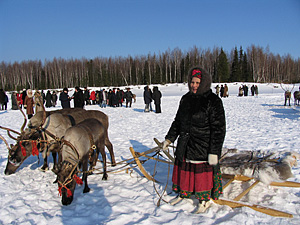
Den’ Olenevoda (Reindeer-Breeder's Day), celebrated in March 2006, in Kazym (Ugra, Khanty-Mansi Autonomous Okrug) – a photo set by Flickr user ugraland/Irina Kazanskaya
While Moscow is braving an atypically snowless and warm winter, and St. Petersburg is about to drown in its 302nd flood, the rest of Russia continues to exist the way it always does.
One way to begin learning about life in the world's biggest country is by looking through the rest of ugraland‘s informative photos from Khanty-Mansi Autonomus Okrug (aka Yugra, or Ugra). Next thing you know, you'll be booking a flight to Beloyarsky (via Moscow) for March, to attend the local “bear games“: ugraland – a “travel expert” – provides a link, in her profile, to the organization that arranges tours of the nomadic camps. Don't forget to dress warm.
But, before you set out, a doze of reality won't hurt.
LJ user kunstkamera has posted two sets of striking photos from another indigenous location of the Russian North – the village of Nes’, populated by the Nenets people: here and here. (Warning: bandwidth intensive – but really, really worth it.)
She wrote (RUS):
The village feels depressing and hopeful at once. It's like a small-town market – the people aren't too friendly, say bad things about each other, told us a story of drunk Nenets guys who had a fight with an ethnic Russian policeman and ended up cutting off his head…
Still, in Nes’ – unlike in the neighboring [Arkhangelsk region], which is much more traditional, meaningful, but still on the verge of dying out – there is the feeling of life: half-nomadic, not making any sense, without the past and without the future, but life nevertheless. There are many “Burans” hurrying back and forth, many children, and the church doesn't stand empty. A temporary life that has turned into permanent home.
As you know, the Soviet regime aimed at limiting the independence of small-numbered peoples – and for this reason, it was doing all it could to make most of the Nenets and [Komi] people resemble the rank-and-file Soviet citizens. From age 7, the nomads’ children were taken away to boarding school, and right after that, to the army, after which they returned as completely different people – as a rule, they drank heavily, were obedient and could hardly speak their native language. The village of Nes’, an administrative center, was fitted for such “cultured” Nenets people. About 1,200 people live in it now – there are Nenets, Komi and Russians among them. For the Nenets, unlike for the Komi, there exist many benefits that are supposed to help save their heritage. But, unfortunately, this money, for the most part, is spent on alcohol that the Mongoloid Nenets don't need much of. The deer-breeders’ children still attend boarding school, though the rules of their stay there have softened somewhat: as their parents are passing by with their herds, they are allowed to take the children along with them for the weekends and vacations.
[32 photos from the village and the boarding school]






